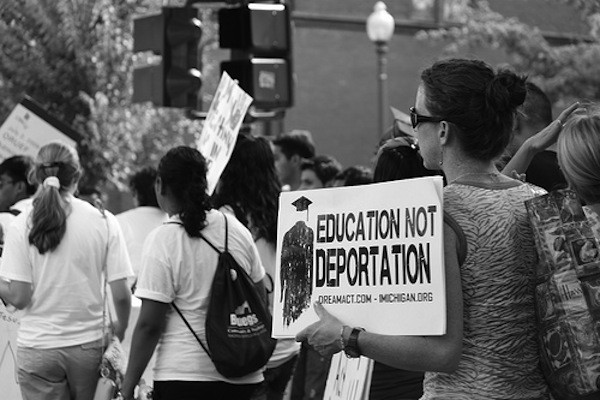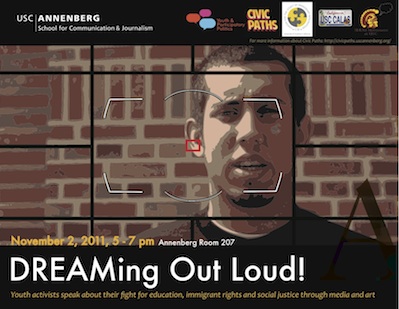Media, Youth Activism & Participatory Politics: Case Studies in a Digital Age

The growing use of digital media for social change is nourishing a dialogue about its impact on young people’s involvement in civic and political affairs. The Media Activism Participatory Politics (MAPP) project, an undertaking of the MacArthur Network on Youth and Participatory Politics (YPP), was created to further that conversation by examining youth-led organizations that encourage productive forms of participation in the public sphere.
MAPP's case study on the DREAM activist movement is the first of four case studies from Henry Jenkins' Civic Paths project at the University of Southern California. The four projects examine exemplary youth organizations and networks where new media tools and practices are woven into the fabric of the community. The undocumented youth movement serves as a key example of how young people are appropriating the affordances of digital media to empower themselves and their community. While working to pass the DREAM Act, young activists have used digital media to rally many across the country around the fight for immigration rights and education.
Six activists encountered by Civic Paths during the DREAM case study, five of whom are undocumented, gathered this week to speak about their fight for social justice through social media and the web at USC Annenberg’s “DREAMing Out Loud!” event. Speaking to a standing-room-only audience, the panelists shared various forms of media and art including photography, websites, blogs, and YouTube videos. 
“This is a case where young people have been very forcefully involved in a dialogue about the future of citizenship in America and have used new media in imaginative and innovative ways to broaden the conversation and force issues on national consciousness that weren't being heard before,” said Jenkins.
The case study presented an opportunity for USC postdoctoral research fellow Arely Zimmerman, whose background is in immigrant civic engagement, and the Civic Paths research team to explore the idea of an online participation gap. The 25 individuals who were interviewed for the case study came from diverse socio-economic backgrounds, which allowed researchers to closely analyze this gap and how youth found creative ways to overcome this gap in order to create, distribute and deploy new media for civic and political ends.
“Their undocumented status makes them a very vulnerable population," Zimmerman said. "This vulnerability serves as a barrier to being politically active, but new media has been an essential key in allowing these youth to find each other and connect via online spaces. It’s that first step in disclosing among their peers what they’ve gone through, and then it’s about that mobilizing factor of connecting them to more formal forms of political participation in their communities and youth groups."
The online participation gap was a topic of much discussion and one that deeply resonated with panelists, whose names are being withheld in this post out of sensitivity to their situations.
“Since I first started blogging," one panelist said, "I’ve never had full access to a computer - I was always going to the public library or going to a friend’s house. So in 2007, I did the smartest thing I’ve ever done, I bought a smartphone. For me, the biggest barrier has been the financial one. I come from a working class family, so there’s always been that lack of access to digital media and the Internet. Now I use my iPhone to update my Twitter and Facebook accounts. It has become my camera, my recorder, my Wi-Fi, and my notebook.”
The DREAM Act case study also points to the underlying importance of digital and media literacy in youth’s ability to participate in their communities both civically and politically in the digital age. One panelist developed digital media literacy skills by applying lessons he’d learned in the classroom when creating his own online content.
“For me, everything came together seamlessly because of journalism. My teacher has been in the business for many years, and she encouraged me to put those old skills to use and apply them to social media. I took what I learned from her and mastered a new form of communication.”
Another panelist, who chairs the communications committee for Dream Team LA, focused on her ability to use her new media skills to gain leverage with the outside media by engaging in real-time dialogue through social network sites such as Twitter.
“We have a strong message and are very strategic. A lot of the work we do is linking traditional media with new media. It’s very important that we have strong relationships with the media. I can tweet a message or contact reporters via Twitter and they will respond much faster than if I were to send out a press release via email or make a phone call.”
A new form of activism, described by one panelist as “Facebook activism,” has also become an effective online strategy for DREAM activists. It involves encouraging supporters to change their Facebook profile pictures to an image created for a specific event or cause and subsequently posting links to information that pertains to the cause such as petitions or demonstration information.
“Social media is a space where we can freely express ourselves. We will ask ourselves, is our hashtag catchy? Does it accurately portray our point? We use the old theories of messaging and combine them with these social media tools to create a new, free and easy way of distributing our message.”
Banner image credit: j valas images http://www.flickr.com/photos/jvalasimages/4836436661/in/photostream/